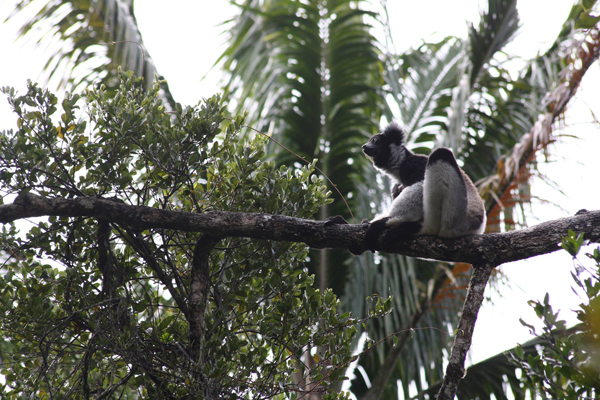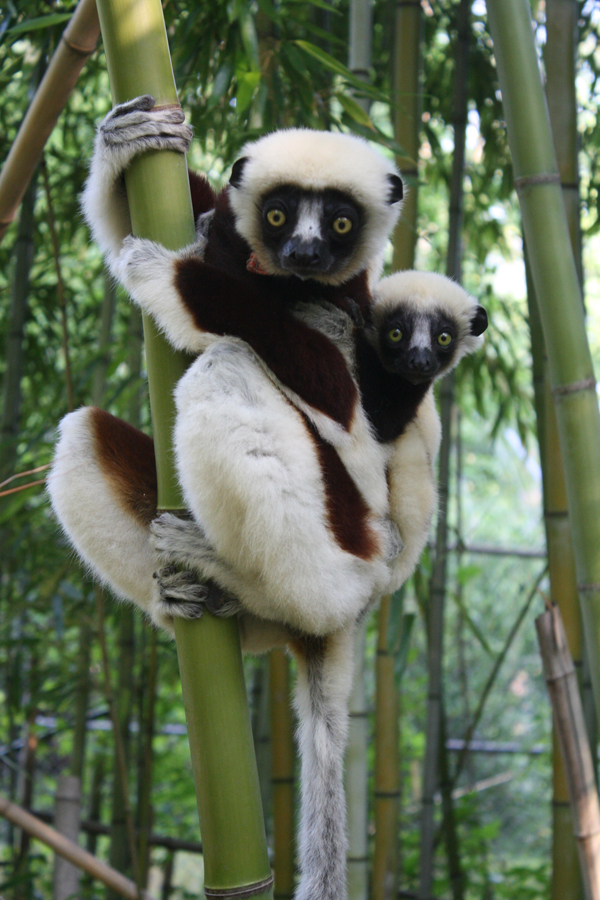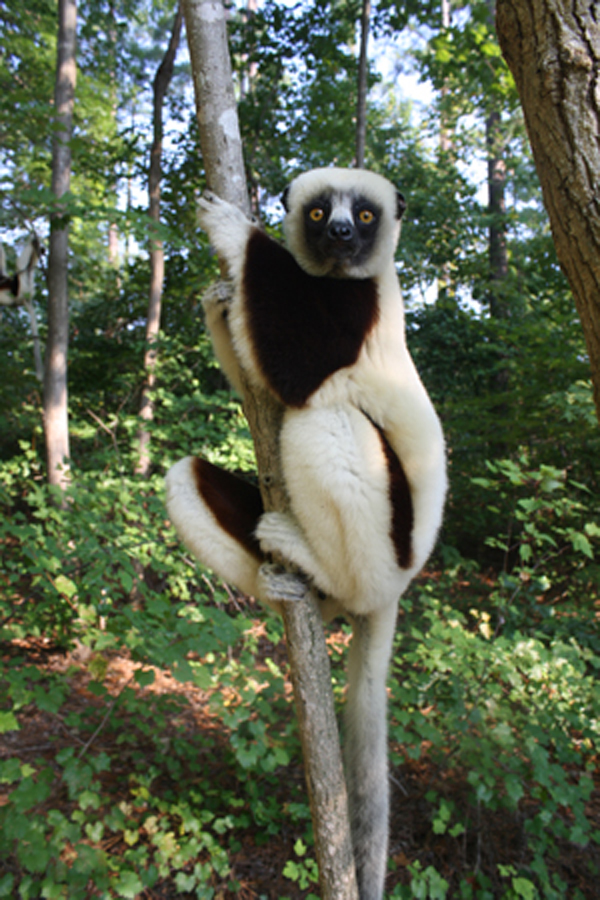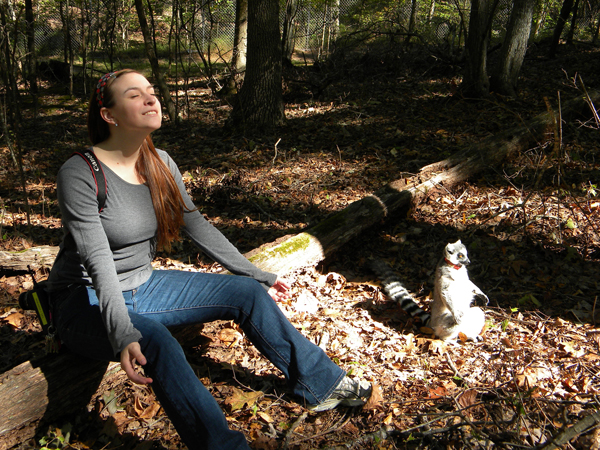Up Close with Lemur Gut Bugs
By Lydia Greene
The World Lemur Festival starts today, and is a great occasion to celebrate these charismatic primates—and their poop.
October 29, 2015
Macroscope Biology

Lydia Greene
For the World Lemur Festival, which starts today, many people are celebrating these cute, bug-eyed primates from Madagascar with their inquisitive look and charismatic personalities. As a lemur researcher, I’m also celebrating their poop.
I study both wild and captive lemurs to explore the links between health, diet, habitat, and gut microbiomes in the hopes of better understanding how to keep captive and wild lemurs healthy. What this means, practically, is that I spend much of my time collecting feces to identify the bacteria inhabiting lemur gastro-intestinal tracts. I collect so much poop that I’m considering calling my dissertation “the proof is in the pooping.”
It might not sound like a fun job, but the potential benefits to lemurs make it worth the discomfort. Not much is known about the lemur gut microbiome, except that it comprises trillions of bacteria and differs between lemurs consuming different diets (e.g. folivores vs. frugivores). Nonetheless, understanding how gut microbiomes relate to lemur nutrition, physiology, and health could help their survival as their habitat becomes more fragmented.
Although they are the most threatened mammals on the planet, lemurs seem to be everywhere these days, from movies to cereal boxes, bumper stickers, and board games. Yet long before lemurs leapt into the public limelight, scientists were interested in studying their morphology, behavior, and natural history. That’s because for researchers such as me, lemurs are perhaps the most fascinating animals on Earth. They share much of their evolutionary history with humans, so many of us study lemurs in the hopes of better understanding our own past and present. But, of all our primate relatives, lemurs are the most distantly related to humans, branching off from our family tree some 60 million years ago to pursue life in Madagascar, already an isolated island with distinctive flora and fauna. Lemurs are therefore a part of us, but are also apart from us.
My own research on lemurs is not only inspired by their relationship with us, but also comes from a desire to ensure their continued survival in Madagascar. My passion for lemurs and conservation developed during my undergraduate years at Duke University, which houses the Duke Lemur Center, a unique facility that has the largest colony of lemurs outside of Madagascar. More than 250 lemurs from about 20 species call the Lemur Center their home. In addition, the center engages in on-the-ground conservation, primarily in Madagascar’s northeastern SAVA (Sambava-Andapa-Vohemar-Antalaha) region.

Lydia Greene
I started out as a tour guide at the Duke Lemur Center during my freshman year of college in 2007; of all the kinds of lemurs, I was most fascinated by the sifakas (right), and wrote my undergraduate thesis on sifaka olfactory communication. Although my research pursuits in the following years took me away from lemurs, I kept coming back to these charismatic primates and am now pursing my PhD at Duke on sifakas and their close relatives, the indris and woolly lemurs, both at the Lemur Center and in Madagascar’s Eastern rainforest.
As a lemur researcher broadly interested in behavior, health, and conservation, I am often asked why I choose to study lemurs living in captivity. Surely studying animals in their natural habitat is always preferable? Well, like most things in science (and in life), the answer is that, it depends. It depends on the research questions, the methods, and the logistics. To start with, many populations of wild lemurs are not habituated to human presence, so they bolt when they see us, and lemurs are anything but slow. Working with nonhabituated lemurs makes collecting fecal samples incredibly difficult and observing natural behavior nearly impossible. Such experiences may not only be stressful for lemurs, affecting their overall health, but may also influence the data we collect. Moreover, many populations live in habitats that are marginally or completely inaccessible to us: I’ve tried to follow lemurs through dense Malagasy rainforests and emerged with both shredded clothing and skin, but without a single fecal sample.

Lydia Greene
Although some of these constraints are potentially solvable with tenacity and significant luck, there are some research questions that are better addressed using a captive population. For example, I am currently examining how lemur gut bacteria are affected by nutrition. In the wild, I broadly relate lemur habitat quality and seasonality to lemur gut microbiomes, but cannot control what wild lemurs eat. With captive lemurs, all of which have documented life histories, I can vary certain components of their diet (such as the fruit or leaves they consume), and thereby reveal a more direct relationship between diet and gut bacteria. I use captive sifakas as a model for their wild relatives, and working with captive lemurs will ultimately help me predict how wild lemurs will respond to increased habitat destruction or environmental change.
Research at the Duke Lemur Center therefore is both conclusive and controlled, as well as conducted with logistical and financial ease. Resident lemurs live with their kin or reproductive partners; they have large, forested enclosures in which to romp around when temperatures allow; and they have access to the best possible veterinary care. They also eat reliable and nutritious food: Duke lemurs have a better diet than most Duke students!

Kathleen Grogan
Without question, studying lemurs in nature is crucial, but good, noninvasive captive studies can also provide invaluable information. Who knows, perhaps a lemur in hand is worth two in a proverbial Malagasy bush.
American Scientist Comments and Discussion
To discuss our articles or comment on them, please share them and tag American Scientist on social media platforms. Here are links to our profiles on Twitter, Facebook, and LinkedIn.
If we re-share your post, we will moderate comments/discussion following our comments policy.